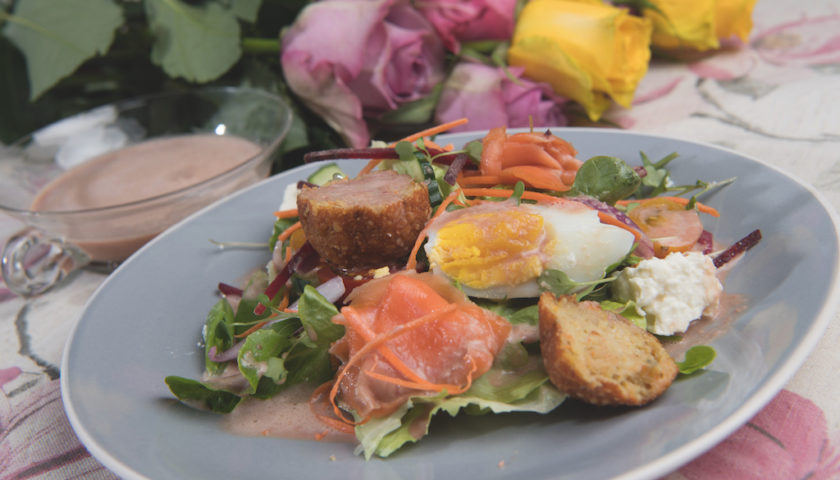Honey is a key feature of the Rosh HaShanah table – but ever wondered where it comes from and why it’s kosher?
By Chandrea Serebro
One of the enduring features of the Rosh Hashanah table, and one that the kids and even most adults love the most, is the honey pot. It’s a sweet year we are after, and all the better that we get to indulge in this most wonderful of natural sweetness that is honey to symbolise that. It’s not for no reason that the land of Israel is called the land of milk and honey – the ultimate sweetness (although the honey referred to in that famous phrase from the Torah is actually date honey, not bees honey). And this is just how we want our year to be. It’s also how we want our kinderlach to view Torah learning, which is why some have the minhag (custom) that when children enter cheder and begin learning the aleph beis, they lick honey off of the letters so that they should associate Torah learning with sweetness.
Are the creatures that create honey as fearsome as we imagine?
The moment we open a tin of cold drink, it feels like every bee and its cousin finds us, and it is a scary feeling to hear that buzz coming out of the tin as you lift it to your mouth. But in fact, bees are endangered, says Lantz Mattinson of the Southerns Beekeeping Association – in that, as Lantz says, “humans are doing a great job at killing all the bugs and the earth”, which is rather short-sighted when one considers that a third of human food supply depends on insect pollination, most of which is accomplished by bees. “But luckily nature is resilient. The best thing we can do is stop using poisons and start planting food for nature,” says Lantz.
Despite the shortage of these buzzing busy bodies, the numbers sure sound impressive. According to the Southerns Beekeeping Association, the average colony of bees consists of 40 000 and can go up to 80 000 bees, all doing their thing to please their queen, and of course, make more honey. And, while there are over 20 000 bee species around the world, only 17 of them make honey, which makes it even more special. Contrary to what many might think, honeybees are not pests. They are a highly developed species of the animal world and contribute significantly to the sustainability of the eco-system in all areas – urban environment, farming areas, and bush lands, according to the Southerns Beekeeping Association. In Africa alone there are an estimated 3000 species of bees, including the infamous African Killer Bees – the bees that achieved notoriety in South America and southern North America after they were introduced from a Pretoria apiary for experimental breeding purposes.
How do bees make honey?
Honey is actually not produced by a bee’s body, but merely stored there. Honey is made from the nectar of flowers, shrubs, and trees which the female worker bee, as the foraging bee, sucks up and then stores in a sac (known as a honey stomach) in her body. While the nectar is in the sac in her body, certain enzymes from her saliva break down the nectar into simple sugars. On return to the hive the foraging bees transfer the digested nectar to other younger house bees in the hive. These house bees also digest the nectar in their own honey sacs before they regurgitate small quantities of the nectar into the honeycomb cells. The bees get rid of the excess water by fanning the honeycomb with their wings, and when the honey is just right, they seal the honeycomb with wax, ready to go. And ready for any one of the myriad things we use honey for today – for beauty and cosmetic purposes due to its moisturising and healing elements, for medicinal uses because of its anti-bacterial and antiseptic qualities, for healing small cuts and soothing sore throats, and of course, as the most natural, tastiest, and healthiest sweetener of all things. Perfect for dipping apples into, too.
So why is honey kosher?
According to the gemara, honey is kosher “since it is not an actual secretion of the bee; the bee functions only as a carrier and facilitator. Honey is kosher flower nectar, which enters the bee’s honey sac and is transformed into honey”. But that’s not the end of the story. Another opinion in the gemara maintains, rather, that honey is kosher based upon a specific verse in the Torah (Vayikra 11:21) that says so. “Therefore, the halacha is that honey is kosher despite the fact that it comes from the non-kosher honeybee.”[1]
At the end of the day, if we leave bees to do what they were meant to do, we will realise that they are the very things that give us the symbol of our own hopes and prayers of sweetness and goodness for our year, through their honey. Just like the honeybee is unique to all other bees, so too is its honey unique to all other foods as well. Honey is the only thing produced by a non-kosher animal that is still kosher. And, perhaps, on Rosh Hashanah the lesson here is that goodness can come out of even the most unlikely of places, so never give up on or judge anyone.
For more information, visit: http://beekeepers.co.za
- Do Bee Don’t Bee – A Halachic Guide to Honey and Bee Derivatives https://www.star-k.org/articles/kashrus-kurrents/624/do-bee-dont-bee/#_ftn1 ↑




